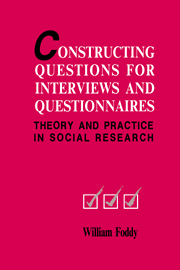Book contents
- Frontmatter
- Contents
- Tables
- Figures
- Preface
- Chapter 1 An initial statement of the problem
- Chapter 2 A theoretical framework
- Chapter 3 Defining topics properly
- Chapter 4 Formulating intelligible requests for information
- Chapter 5 Contextual influences on respondents' interpretations of questions
- Chapter 6 The need to provide response frameworks
- Chapter 7 The limitations of human memory
- Chapter 8 Filters: establishing the relevance of questions to respondents
- Chapter 9 Reducing question threat
- Chapter 10 The open vs. closed questions debate
- Chapter 11 Measuring attitudes
- Chapter 12 Checks to ensure that questions work as intended
- Chapter 13 Concluding comments
- The tap paradigm
- References
- Index
- Acknowledgements
Chapter 5 - Contextual influences on respondents' interpretations of questions
Published online by Cambridge University Press: 04 September 2009
- Frontmatter
- Contents
- Tables
- Figures
- Preface
- Chapter 1 An initial statement of the problem
- Chapter 2 A theoretical framework
- Chapter 3 Defining topics properly
- Chapter 4 Formulating intelligible requests for information
- Chapter 5 Contextual influences on respondents' interpretations of questions
- Chapter 6 The need to provide response frameworks
- Chapter 7 The limitations of human memory
- Chapter 8 Filters: establishing the relevance of questions to respondents
- Chapter 9 Reducing question threat
- Chapter 10 The open vs. closed questions debate
- Chapter 11 Measuring attitudes
- Chapter 12 Checks to ensure that questions work as intended
- Chapter 13 Concluding comments
- The tap paradigm
- References
- Index
- Acknowledgements
Summary
Throughout this chapter, the focus will be on the second step in the question–answer communication cycle (figure 5.1, p. 53).
Chapters 2 and 3 were directed at the problems that have to be confronted when formulating a question. We saw that there is a great deal of scope for slippage in communication between the researcher and the respondents. Researchers may be unclear about the topic they want to investigate and thus about the nature of the information they want to collect. They may use words that are not understood by the respondents. They may construct questions that are too complex for the respondents to comprehend. We saw, too, that the fact respondents answer a question is not, in itself, proof that the question has worked as the researcher intended it to work. It appears that respondents do their level best to answer all questions that are put to them — even those they have trouble interpreting (Belson, 1981; Strack and Martin, 1987). Of course:
In principle, any ambiguity the respondent is aware of could be resolved by asking for clarification. In surveys, however, further explanation is typically not available and … may even be discouraged for the sake of standardization … In this situation, the respondent may use other available information to infer what the researcher wants to know.
(Strack and Martin, 1987:127)- Type
- Chapter
- Information
- Constructing Questions for Interviews and QuestionnairesTheory and Practice in Social Research, pp. 52 - 75Publisher: Cambridge University PressPrint publication year: 1993



